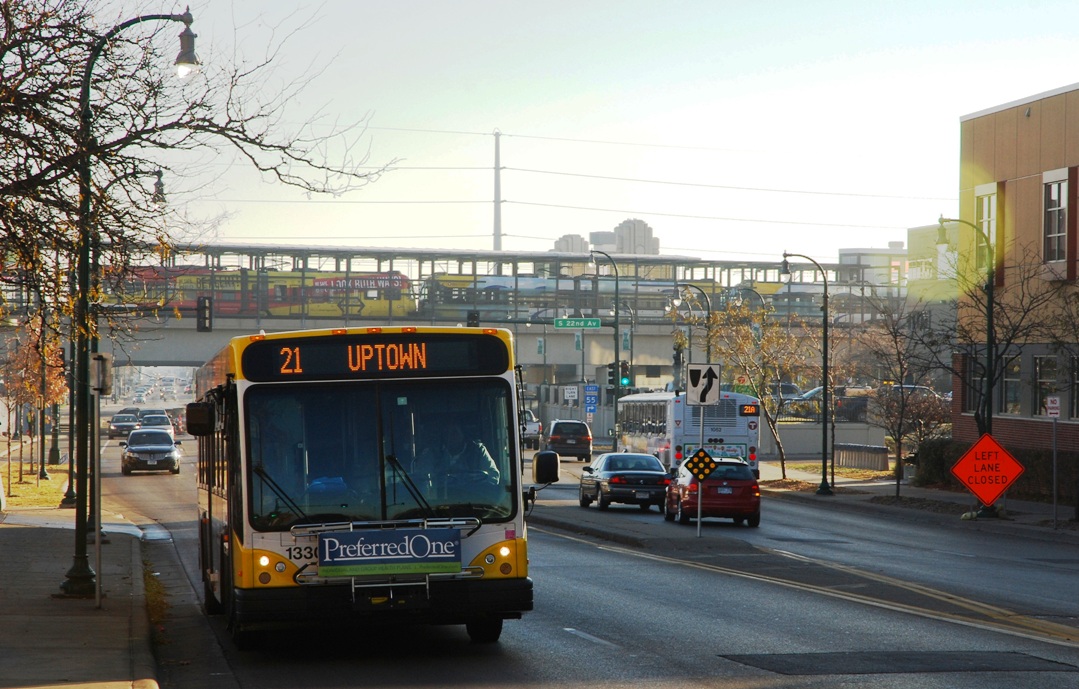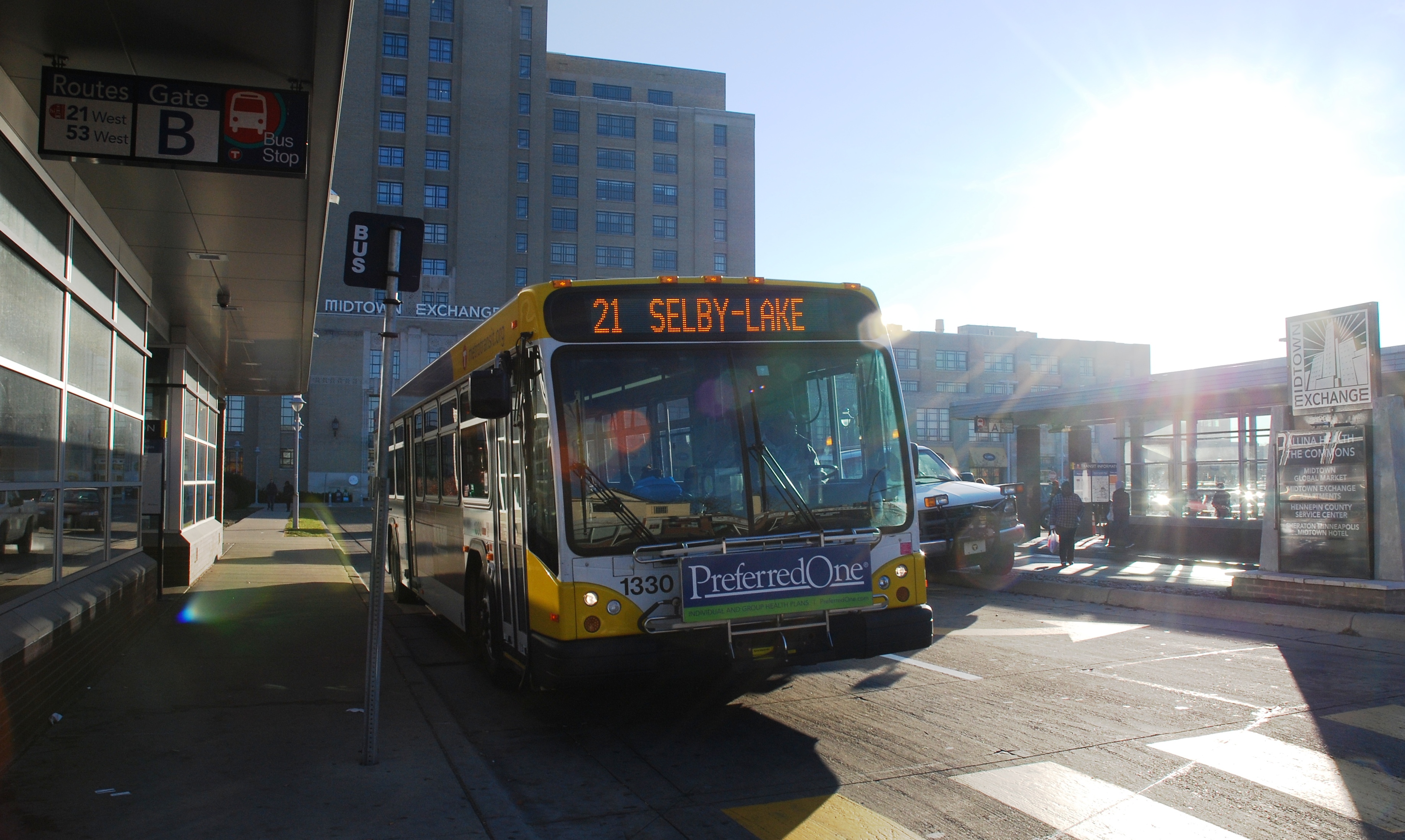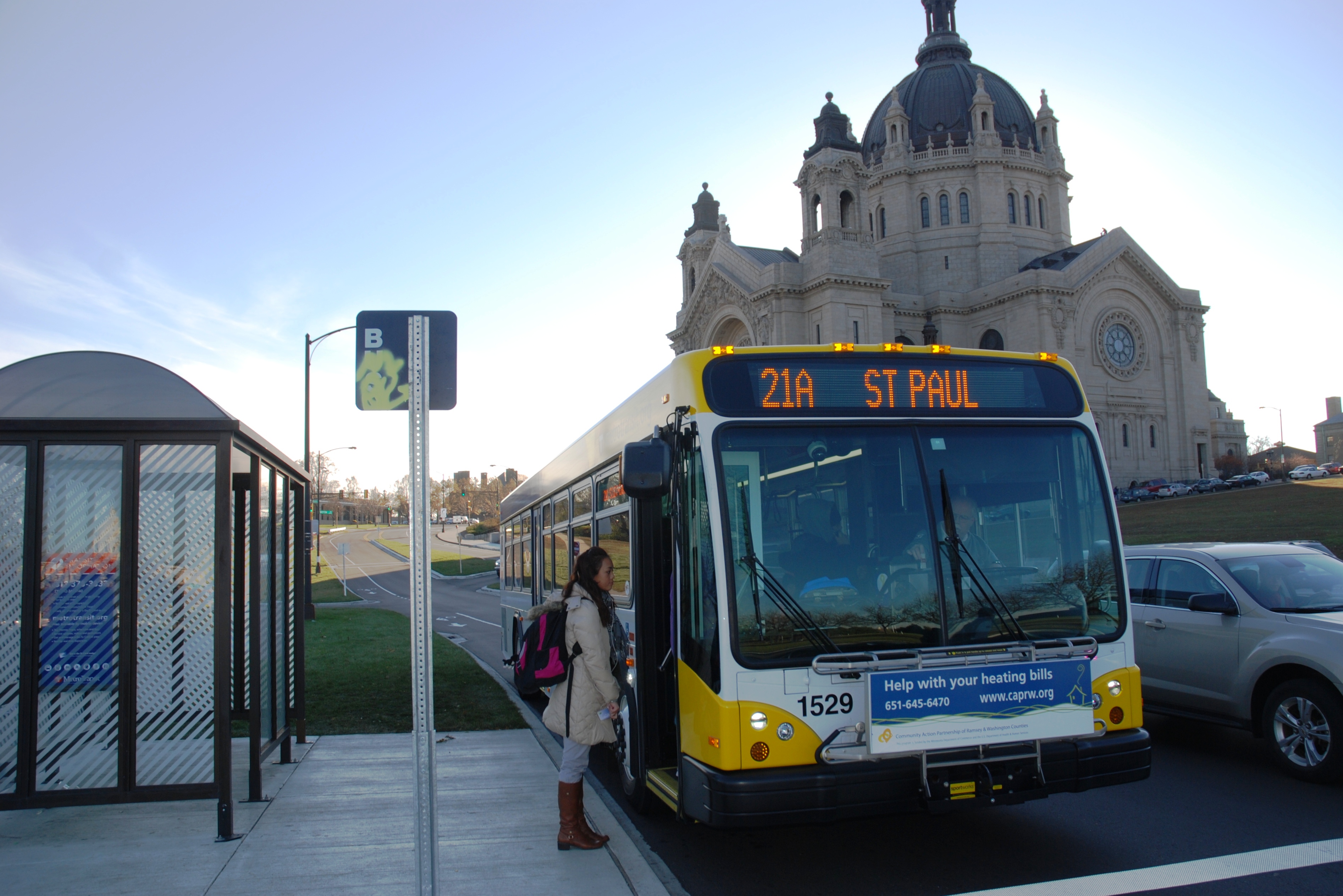
When Hannah Ankeny’s car died three years ago, she decided to forego buying a new one and rely on transit instead.
Today, getting to her job at Parkway Middle School Montessori on St. Paul’s east side means taking Route 21 from her home in the Summit-University neighborhood downtown where she transfers to Route 74. Besides work, Ankeny uses Route 21 to travel west on Lake Street, where she enjoys the small shops and restaurants that line the busy commercial corridor.
“I tell everyone that you can’t get a better cultural experience in the Twin Cities than on Route 21,” Ankeny said recently as she returned from work. “If you ride all of Lake Street, you can get a glimpse of everyone who lives in the Twin Cities.”
The cross-cultural experience is perhaps the hallmark of Route 21, which became the subject of a Kevin Kling play, “21A,” profiling a unique collection of customers. But it’s not the only calling card for the historic crosstown route, described by Minnesota Monthly as the "bus route that binds the Twin Cities together."
Customers interviewed on Route 21 said they rely on the bus to get to work, class, connecting bus routes and reach the METRO Blue Line's Lake Street/Midtown Station.
Running east from Uptown Transit Center, destinations on Route 21 include Chicago Lake Transit CenterMidtown Global Market and Powderhorn Park. After crossing the Lake Street Bridge to St. Paul, the route travels on Marshall Avenue before veering north to University Avenue, where it meets the METRO Green Line's Snelling and Hamline avenue stations. Buses enter downtown via Selby Avenue, connecting with the Green Line's Central Station and the newly-renovated Union Depot (Route 21 was the first route to run to the newly-renovated transit hub when it re-opened in 2012).
Rowan Doyle, a ninth grader at South High School, was among a group of students traveling eastbound on a recent early-morning Route 21 bus. In 2013, South and Southwest high schools were added to the Student Pass program, which provide students passes that allow unlimited rides on regional buses and trains.
Doyle said he not only uses the bus to get to school but to visit the Midtown Global Market and to connect with the Blue Line and get to the Mall of America. “I use it to get pretty much anywhere, especially when it’s cold outside,” he said.
While Doyle is relatively new to transit, Ernest Farley has been riding Route 21 and other routes for the better part of 40 years. Farley was recently aboard Route 21 traveling to the Walker West Music Academy on Selby Avenue where he studies piano. A retired veteran, Farley also takes the bus to church, volunteer and connect with the Blue Line so he can get to the VA Medical Center.
 “You couldn’t give me a car at this point in my life,” Farley said.
“You couldn’t give me a car at this point in my life,” Farley said.
Farley’s memory dates to the old red buses that operated without modern amenities like temperature control or power steering. But he hasn’t been around the Twin Cities long enough to have ridden the predecessor to the Route 21: streetcars on the Selby-Lake line.
Opened in 1906, the Selby-Lake line was one of the most important crosstown connections in the Twin Cities’ burgeoning streetcar system. At its peak, it carried more passengers per mile than any other streetcar route in the system.
Buses replaced streetcars in 1953 but the corridor has continued to see heavy transit use.
Route 21 was the third most-used Metro Transit route last year, with nearly 4.3 million customer boardings. While ridership is at its highest during peak periods, Route 21 sees steadier all-day demand than most other routes.
Acknowledging the demand, planners have looked at ways to overcome streetlights, traffic and other factors that slow buses through the Lake Street corridor. In early 2014, the Midtown Corridor Alternatives Analysis concluded with a recommendation for enhanced bus service on Lake Street and rail in the Midtown Corridor.
Whatever the speed, Dan Mortensen says he wouldn’t commute to work any other way than by using Route 21. Mortensen grew up riding Route 21 to Uptown and now takes the bus to the Blue Line, which he uses to get to work downtown. The entire trip takes roughly a half hour. “I don’t ever want to drive to work,” he said. “It’s just not fun.”
Mortensen’s maturation on the line is common. When longtime Route 21 bus operator Karen Krech passed away in 2012, customers who grew up riding with the longtime driver recalled growing up with her and later inviting her to graduations and other life milestones.
Joyce Wisdom, the executive director of the Lake Street Council, said the lore around Route 21 has given it unique stature in the neighborhoods it knits together.
“It seems to me that the 21, for so many generations and so many decades, has been such a vital piece of transportation,” she said. “I don’t know that you have any other route quite like it.”
 Route 21 At a Glance
Route 21 At a Glance
Type: Urban Local
Service: Route 21 runs between the Uptown Transit Station on Hennepin Avenue and the Union Depot in downtown St. Paul. In Minneapolis, buses run on Lake Street, stopping at I-35W and Lake Street, Chicago Lake Transit Center and the METRO Blue Line’s Lake Street/Midtown Station. After crossing the Mississippi River on the Lake Street bridge, Route 21 buses continue on Marshall Avenue, north to University Avenue via Snelling and Hamline Avenues, then east on Selby Avenue to downtown St. Paul. The section of Route 21 between Hennepin Avenue and the Mississippi River is part of Metro Transit’s Hi Frequency Network in which buses operate at least every 15 minutes weekdays from 6 a.m. to 7 p.m. and on Saturday’s from 9 a.m. to 6 p.m. Route 21 operates between approximately 4 a.m. and 2 a.m. An end-to-end trip is scheduled to take just under an hour. Destinations on the Route 21 corridor in Minneapolis include Uptown, the Midtown Exchange Building, Powderhorn Park and South High. The route parallels the Midtown Greenway, which sits just north of Lake Street. In St. Paul, destinations include University of St. Thomas (served by Route 21’s D branch), the Midway Shopping Center, Concordia University and St. Paul College. Route 53 runs a similar course as Route 21 between the Uptown Transit Station and downtown St. Paul, providing limited stop service during peak hours.
Route length: Approximately 12 miles
Vehicles: 40-foot standard buses
Stops: 100 eastbound, 92 westbound
Ridership: Nearly 4.3 million customer boardings in 2012, with an average of around 11,697 boardings per day
History: The Selby-Lake Streetcar line opened in 1906, following the construction of the Lake Street/Marshall Avenue bridge over the Mississippi River. It soon became one of the most important crosstown connections in the burgeoning streetcar system, with more passengers per mile than any other route and 60 streetcars in service during rush hour. As ridership grew, Lake Street went from an unpaved road to a busy commercial corridor. In St. Paul, a cable car up Selby Hill opened in 1887, serving residents who lived on or near Summit and Marshall avenues. The line was later electrified and extended west, The Selby-Lake line was taken out of service in 1953, amid the conversion from streetcars to buses. On West Lake Street, Museum in the Streets chronicles some of the transportation and related history that exists in the corridor.
FutureRoute 21 will be a key feeder to the METRO Green Line, connecting with the Union Depot and Central stations in downtown St. Paul and Hamline Avenue and Snelling Avenue stations on University Avenue. When the Green Line opens on June 14, weekday evening service will be .Concluded in early 2014 the Midtown Corridor Alternatives Analysis recommended a improved transit station at I-35W & Lake Street. The new I-35W-Lake Street Station would serve as a stop on the METRO Orange Line, a planned Bus Rapid Transit system that would run between downtown Minneapolis and Burnsville.